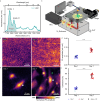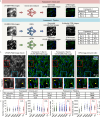Unsupervised inter-domain transformation for virtually stained high-resolution mid-infrared photoacoustic microscopy using explainable deep learning
- PMID: 39738110
- PMCID: PMC11685655
- DOI: 10.1038/s41467-024-55262-2
Unsupervised inter-domain transformation for virtually stained high-resolution mid-infrared photoacoustic microscopy using explainable deep learning
Abstract
Mid-infrared photoacoustic microscopy can capture biochemical information without staining. However, the long mid-infrared optical wavelengths make the spatial resolution of photoacoustic microscopy significantly poorer than that of conventional confocal fluorescence microscopy. Here, we demonstrate an explainable deep learning-based unsupervised inter-domain transformation of low-resolution unlabeled mid-infrared photoacoustic microscopy images into confocal-like virtually fluorescence-stained high-resolution images. The explainable deep learning-based framework is proposed for this transformation, wherein an unsupervised generative adversarial network is primarily employed and then a saliency constraint is added for better explainability. We validate the performance of explainable deep learning-based mid-infrared photoacoustic microscopy by identifying cell nuclei and filamentous actins in cultured human cardiac fibroblasts and matching them with the corresponding CFM images. The XDL ensures similar saliency between the two domains, making the transformation process more stable and more reliable than existing networks. Our XDL-MIR-PAM enables label-free high-resolution duplexed cellular imaging, which can significantly benefit many research avenues in cell biology.
© 2024. The Author(s).
Conflict of interest statement
Competing interests: J.A. and C.K. have financial interests in OPTICHO, which, however, did not support this work. All other authors declare no competing interests.
Figures





Similar articles
-
Reconstructing Cancellous Bone From Down-Sampled Optical-Resolution Photoacoustic Microscopy Images With Deep Learning.Ultrasound Med Biol. 2024 Sep;50(9):1459-1471. doi: 10.1016/j.ultrasmedbio.2024.05.027. Epub 2024 Jul 7. Ultrasound Med Biol. 2024. PMID: 38972792
-
Virtual optical-resolution photoacoustic microscopy using the k-Wave method.Appl Opt. 2021 Dec 20;60(36):11241-11246. doi: 10.1364/AO.444106. Appl Opt. 2021. PMID: 35201116
-
High-Speed Ultraviolet Photoacoustic Microscopy for Histological Imaging with Virtual-Staining assisted by Deep Learning.J Vis Exp. 2022 Apr 28;(182). doi: 10.3791/63649. J Vis Exp. 2022. PMID: 35575523
-
Sounding out the hidden data: A concise review of deep learning in photoacoustic imaging.Exp Biol Med (Maywood). 2021 Jun;246(12):1355-1367. doi: 10.1177/15353702211000310. Epub 2021 Mar 27. Exp Biol Med (Maywood). 2021. PMID: 33779342 Free PMC article. Review.
-
A Tour of Unsupervised Deep Learning for Medical Image Analysis.Curr Med Imaging. 2021;17(9):1059-1077. doi: 10.2174/1573405617666210127154257. Curr Med Imaging. 2021. PMID: 33504314 Review.
Cited by
-
In vivo 3D photoacoustic and ultrasound analysis of hypopigmented skin lesions: A pilot study.Photoacoustics. 2025 Mar 8;43:100705. doi: 10.1016/j.pacs.2025.100705. eCollection 2025 Jun. Photoacoustics. 2025. PMID: 40161359 Free PMC article.
-
Multi-photon, label-free photoacoustic and optical imaging of NADH in brain cells.Light Sci Appl. 2025 Aug 7;14(1):264. doi: 10.1038/s41377-025-01895-x. Light Sci Appl. 2025. PMID: 40775235 Free PMC article.
-
Ultrasound-Mediated Membrane Modulation for Biomedical Applications.Nanomaterials (Basel). 2025 Jun 7;15(12):884. doi: 10.3390/nano15120884. Nanomaterials (Basel). 2025. PMID: 40559247 Free PMC article. Review.
-
Photoacoustic imaging detects cerebrovascular pathological changes in sepsis.Photoacoustics. 2025 May 30;44:100737. doi: 10.1016/j.pacs.2025.100737. eCollection 2025 Aug. Photoacoustics. 2025. PMID: 40519982 Free PMC article.
-
A comprehensive review of high-performance photoacoustic microscopy systems.Photoacoustics. 2025 Jun 4;44:100739. doi: 10.1016/j.pacs.2025.100739. eCollection 2025 Aug. Photoacoustics. 2025. PMID: 40528993 Free PMC article. Review.
References
-
- Pawley, J. Handbook of Biological Confocal Microscopy, 236. (Springer Science & Business Media, 2006).
-
- Lichtman, J. W. & Conchello, J.-A. Fluorescence microscopy. Nat. Methods2, 910–919 (2005). - PubMed
-
- Cutrale, F. et al. Hyperspectral phasor analysis enables multiplexed 5D in vivo imaging. Nat. Methods14, 149–152 (2017). - PubMed
-
- Zimmermann, T., Rietdorf, J. & Pepperkok, R. Spectral imaging and its applications in live cell microscopy. FEBS Lett.546, 87–92 (2003). - PubMed
Publication types
MeSH terms
Grants and funding
LinkOut - more resources
Full Text Sources
Miscellaneous

